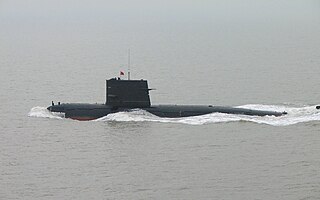Related Research Articles

Sonar is a technique that uses sound propagation to navigate, measure distances (ranging), communicate with or detect objects on or under the surface of the water, such as other vessels.

The Trafalgar class was a class of nuclear-powered fleet submarines (SSNs) in service with the Royal Navy, and the successor to the Swiftsure class. Like the majority of Royal Navy nuclear submarines, all seven boats were constructed at Barrow-in-Furness shipyard, Cumbria. The class made up part of the Royal Navy's nuclear-powered ‘hunter-killer’ submarine force. The Trafalgar class was replaced by the larger and more capable Astute class, of which five are commissioned.

The Vanguard class is a class of nuclear-powered ballistic missile submarines (SSBNs) in service with the Royal Navy. The class was introduced in 1994 as part of the Trident nuclear programme, and comprises four vessels: Vanguard, Victorious, Vigilant and Vengeance, built between 1986 and 1999 at Barrow-in-Furness by Vickers Shipbuilding and Engineering, now owned by BAE Systems. All four boats are based at HM Naval Base Clyde , 40 km (25 mi) west of Glasgow, Scotland.

The Type 23 frigate or Duke class is a class of frigates built for the United Kingdom's Royal Navy. The ships are named after British Dukes, thus leading to the class being commonly known as the Duke class. The first Type 23, HMS Norfolk, was commissioned in 1989, and the sixteenth, HMS St Albans was commissioned in June 2002. They form the core of the Royal Navy's destroyer and frigate fleet and serve alongside the Type 45 destroyers. They were designed for anti-submarine warfare, but have been used for a range of uses. Nine Type 23 frigates remain in service with the Royal Navy, with three vessels having been sold to the Chilean Navy and four being retired since 2021.

The Upholder/Victoria-class submarines, also known as the Type 2400, are a class of diesel-electric submarines built in the United Kingdom in the 1980s to supplement the nuclear submarines in the Submarine Service of the British Royal Navy.

HMS Astute is an operational nuclear-powered attack submarine in the Royal Navy, the lead boat of her class.

The Astute class is the latest class of nuclear-powered fleet submarines (SSNs) in service with the Royal Navy. The boats are being constructed by BAE Systems Submarines at Barrow-in-Furness. Seven boats will be constructed: the first of class, Astute, was launched by Camilla, Duchess of Cornwall, in 2007, commissioned in 2010, and declared fully operational in May 2014. The Astute class is the replacement for the Trafalgar-class fleet submarines in Royal Navy service.
HMS Artful is the third Astute-class nuclear-powered fleet submarine of the British Royal Navy. She is the second submarine of the Royal Navy to bear this name. Artful was ordered from GEC's Marconi Marine on 17 March 1997, and was constructed at Barrow in Furness. She was named on 20 September 2013, was rolled out of the shipyard construction hall on 16 May 2014, and was due to start sea trials in early 2015. Artful made her first successful basin dive in October 2014, and sailed on 13 August 2015 for sea trials. Artful was handed over the Royal Navy on 14 December 2015, and commissioned on 18 March 2016.

The 46 Knox-class frigates were the largest, last, and most numerous of the US Navy's second-generation anti-submarine warfare (ASW) escorts. Originally laid down as ocean escorts, they were all redesignated as frigates on 30 June 1975, in the 1975 ship reclassification plan and their hull designation changed from 'DE' to 'FF'. The Knox class was the Navy's last destroyer-type design with a steam turbine powerplant.

HMS Matapan (D43) was a later or 1943 Battle-class fleet destroyer of the Royal Navy (RN). She was named after the Battle of Cape Matapan between the Royal Navy and the Regia Marina, which ended in a decisive victory for the RN force, resulting in the destruction of three cruisers and two destroyers of the Italian Navy and was a heavy blow to the Italians. So far, she has been the only ship of the Royal Navy to bear that name.
The Sonar 2087 is a towed array sonar developed by Thales Underwater Systems (TUS). Manufactured in the United Kingdom, it is the British variant of the company's CAPTAS-4 manufactured in Brest, France, and part of its CAPTAS line of products. The Sonar 2087 replaced the older Sonar 2031 in the Royal Navy and equips eight Type 23 frigates. It is also expected to equip the Royal Navy's Type 26 frigates currently in production. The S2087 is also fitted on Chilean Type 23 frigates acquired from the Royal Navy.
Thales Underwater Systems or TUS is a subsidiary of the French defense electronics specialist Thales Group. It was founded in 2001 and belongs to its naval division. It specializes in the development and manufacturing of sonar systems for submarines, surface warships and aircraft, as well as communications masts and systems for submarines. Its headquarters are located in Sophia Antipolis, France.

The Brahmaputra-class frigates are guided-missile frigates of the Indian Navy, designed and built in India. They are an enhancement of the Godavari class, with a displacement of 3850 tons and a length of 126 metres (413 ft). Although of similar hull and dimension, internally, the Brahmaputra and Godavari classes have different configurations, armaments and capabilities. 3 ships of this class serve in the Indian Navy.

The Type 039 submarine is a class of diesel-electric submarines of the People's Liberation Army Navy. The class is the first diesel-electric submarine to be made in China and also the first Chinese made diesel-electric submarine to use the teardrop hull shape. Altogether thirteen vessels were completed to the Song Class design between 1999 and 2006, with three variants as the type developed.

The Type 039A submarine is a class of diesel-electric submarine in China's People's Liberation Army Navy. It is China's first AIP powered submarine. The Yuan class is the successor of the Song class submarine. The class is designed to replace the aging Type 033 and the older Type 035 submarines that previously formed the backbone of the conventional submarine force. The Yuan class is armed with wired-guided and wake-homing torpedoes, long-range land-attack and anti-ship cruise missiles, and naval mines.
SMCS, the Submarine Command System, was first created for the Royal Navy of the United Kingdom's Vanguard-class submarines as a tactical information system and a torpedo weapon control system. Versions have now also been installed on all active Royal Navy submarine classes.

The AN/UQQ-2 Surveillance Towed Array Sensor System (SURTASS), colloquially referred to as the ship's "Tail", is a towed array sonar system of the United States Navy.

HMS Audacious is the fourth Astute-class nuclear-powered fleet submarine of the Royal Navy. Several previous vessels of the Royal Navy have borne the name. She was formally named on 16 December 2016 and was launched on 28 April 2017. Audacious was stated to be handed over in January 2021. A parliamentary written answer stated that Audacious was commissioned on 3 April 2020, but her public ceremonial commissioning took place on 23 September 2021.

The Heroine class are a variant of the Type 209 diesel-electric attack submarine developed by Howaldtswerke-Deutsche Werft (HDW) of Germany, currently in service with the South African Navy. The class is composed of three vessels.

The KSS-III, officially called Dosan Ahn Changho class is a series of diesel-electric multipurpose attack submarines currently being built for the Republic of Korea Navy (ROKN), jointly by Hanwha Ocean and HD Hyundai Heavy Industries (HHI). The KSS-III is the final phase of the Korean Attack Submarine program, a three-phased program to build 27 attack submarines for the ROKN, between 1994–2029.
References
- ↑ "Critical Review". Ares: A Defense Technology Blog. Retrieved 28 May 2023.
- ↑ "Home". www.baesystems.com. Archived from the original on 9 September 2010.
- 1 2 The Market for Undersea Warfare Systems forecastinternational.com
- ↑ "Home". www.baesystems.com. Archived from the original on 26 August 2010.
- ↑ Chris Lo, Peter Don-Duncan (23 August 2010). "Strength in Depth: Sonar Technology". naval-technology.com. Retrieved 1 February 2014.
- ↑ "UK Government Web Archive". webarchive.nationalarchives.gov.uk. Retrieved 28 May 2023.